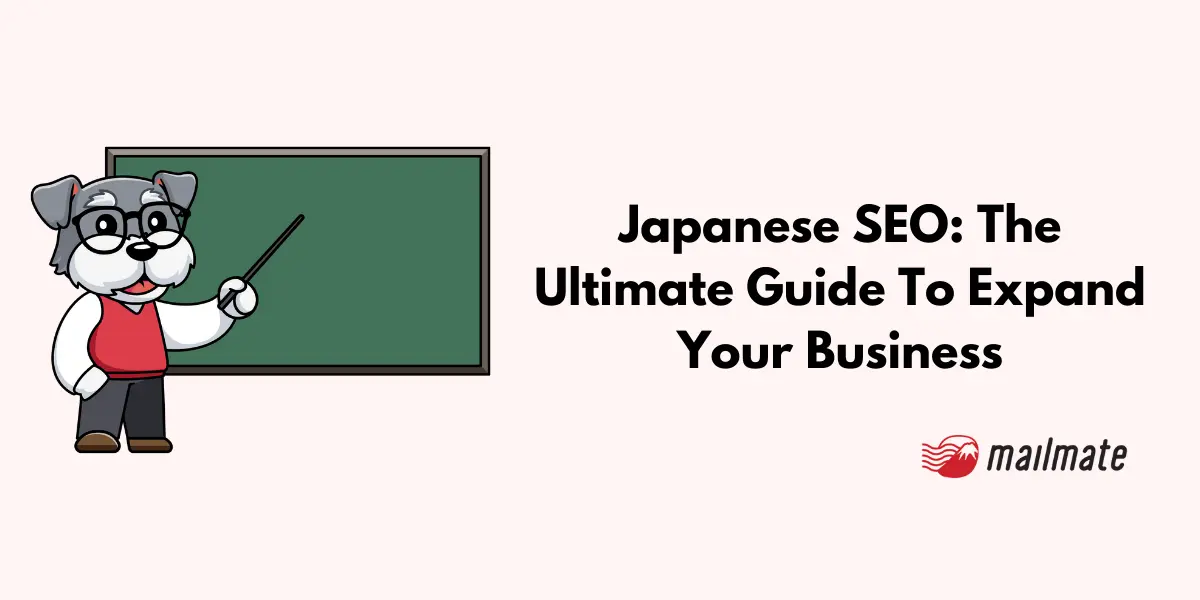Japanese SEO: The Ultimate Guide To Expand Your Business

Foreign companies looking to break into Japanese marketing might be struggling to reach Japanese online users. Are you one of them? It might be time to look at your Japanese SEO strategy!
While many SEO strategies have a basic foundation to apply to any country, looking specifically at Japanese SEO will help you penetrate the Japanese online market.
This guide will help you understand and apply Japanese SEO to your marketing strategy to help you attract Japanese users and boost traffic to your website.
Ask yourself these questions for a successful Japanese marketing strategy
SEO is not an all-in-one tool for a successful Japanese marketing strategy. There are other factors to decide on first before jumping into SEO.
Here are some questions to ask yourself and your team before crafting an SEO strategy.
What are you selling?
Who is your target audience?
Why did your current customer purchase your product? What problems were they looking to solve?
How did current customers find your product or your site?
Asking these questions for your business will help you see a wider range of areas where your customers may be found.
Digital behaviors of Japanese online users
While Yahoo! Japan at one point was Japan’s most popular search engine, now it seems like Google has taken over, according to Statista. So with more Japanese internet users on Google, understanding the Google search algorithm will help you create a better Japanese SEO targeting strategy.
Additionally, it’s important to know about consumer and market behavior in Japan to know how the Japanese online market works.
Furthermore, according to Krows Digital, 93% of the Japanese population is connected to the internet through their phones, so it’s important to focus on the mobile phone experience so that users will want to stay on your website.
6 Japan SEO practices to implement
Here are 6 key Japanese SEO tips to use to help grow your website traffic.
1. Research Japanese keywords
Most people in America will search in English as that is the most common language there.
In Japan, since most people speak Japanese, they will search in Japanese.
For example, an English user might search “seo for beginners,” but a Japanese user might type, “seo とは 初心者.” Here you can see the difference between the language but also the language structure.
Another example would be the term, “office space.” In Japanese, the term is, “オフィススペース.”
The difference in knowing what and how Japanese users are searching allows you to better cater your website and content to these specific keywords.
2. Know the character limits for title and meta description in Japanese SEO
Believe it or not, the title and meta description for English SEO are different from Japanese SEO.
For Japanese SEO, it is recommended to use about 28 characters for the title and 46 characters for the meta description due to Japanese characters taking up wider pixel space.
This character count for Japanese meta info is more limited than for English SEO where the title and meta description should be less than 60 and 160 characters, respectively.
Depending on your Japanese keyword, these character limits are not too limiting since Japanese words can be condensed with kanji. For example, “オフィススペース 個室 ” is 11 characters compared to its English translation, “office space private room,” which is 25 characters.
3. Do not use Google Translate for your content
While the Google Translation App is great for simple transition, we all know it doesn't have the best translation for anything more complex. Especially if you’re going from Japanese to English translation.
The reverse is true as well. Any native Japanese speaker will know that your text was automatically translated by a machine if you use Google Translate.
As an SEO best practice in general, having a native speaker write or translate your content will avoid any awkward phrasing and unnatural sentences.
4. Don’t use Japanese characters in the URL
Many other resources state that your website URLs should use Latin characters instead of non-English letters. But why? Let’s take a look at the image below:

Example website using Japanese characters in the URL
For example, if you copied お名前.com from the URL bar and pasted it elsewhere, it would show up as https://xn--t8jx73hngb.com/. Both URLs are the same, but because Japanese uses non-Latin characters, a Punycode is used for internet processing.
The second URL becomes a problem when linking and sharing your content, which is why instead of using お名前.com, the business uses the romaji reading for the URL instead: onamae.com. This URL is much easier to share and link around.
In the following video, John Müller, a Google Webmaster Trend Analyst, briefly explains how Google handles non-English language in URLs:
Using non-English world in URLs | Google Search Central5. Have a .jp domain
While getting an additional domain will come at an additional cost, it brings many benefits to increase your website in Japan and bring in customers.
For one, your website will get a higher boost in local searches. Combining that with your Japanese keyword will result in a higher chance of being seen by your potential customers.
Additionally, having a .jp domain will let Japanese users know that your site is Japanese-friendly.
Use MailMate’s virtual address for your .jp domain
When obtaining a .jp domain, you will need a Japanese postal address. The easy solution is to use a virtual address service like MailMate!

Legitimate Japanese postal address
You will receive MailMate’s virtual address, which you can use to obtain a .jp domain.
A virtual address is still a physical address, tied to a real, physical location where mail and packages can be received.
Online mail management
If you have Japanese mail, you can now receive them online, just like an email.
MailMate’s online dashboard allows you to open, ready, forward, pay your bills, and shred your mail with a click of a button.
Bilingual support
Non-Japanese-speaking customers of MailMate will receive a translated summary of your mail. Plus, let them know if you are starting a business in Japan, as they will help with incorporation.
However, if you are a global business with an English user base looking to expand to Japan, putting your Japanese language content in a subfolder is also a valid option and will allow you to continue to rank well for your non-Japanese keyword terms.
6. High-quality Japanese backlinks
Backlinks are hyperlinks from different websites that link to yours. These links are like endorsements to search engines telling them that your content is valuable and relevant.
Increased organic traffic
Improved trust and value
Better authority and credibility
For Japanese SEO, it’s best if other Japanese websites link to yours due to local relevance. Thus, gaining backlinks will bring great value to your website such as:
Getting natural backlinks where other websites will link to yours can happen organically, but there are other ways to get Japanese backlinks. Some common ways to gain backlinks in Japan are through guest blogging and fixing broken links.
Designing your website for Japanese SEO
Applying these Japanese SEO practices to your website is a great start.
But if you want to have a dedicated Japanese website, there are a couple of things to take note of.

Japanese vs American Starbucks website
Looking at the Japanese and American websites of Starbucks, they have different layouts and offers. On the American site, there is an emphasis on Starbucks rewards while on the Japanese site, the emphasis is on seasonal drinks and gifts.
The difference in these layouts and designs indicates differences in consumer behaviors between American and Japanese users.
Knowing who your audience is and what they are looking for allows you to design your site to better accommodate their needs and wants.
How to measure your Japanese SEO efforts
It’s important to see how far your Japanese SEO efforts are going and which is making the most impact.
Google Search Console is a free tool by Google to track your website’s performance. It will let you know numbers such as how many users clicked on your site, the number of impressions, your top pages, and key phrases users are typing in to find your site.
Knowing what is getting the most clicks, trends and patterns, and areas for improvement lets you optimize specific areas of your SEO strategy.
Frequently asked questions
How do you do SEO in Japan?
While SEO has a basic outline that many sites can follow, there are things such as Japanese keywords and creating high-quality Japanese content that is written by a Japanese native that will allow you to cater to Japanese search engines more effectively.
What search engine is most used in Japan?
Google has become the most used search engine in Japan. In terms of the market share, Google takes about 76% while Yahoo Japan and Bing make up the rest of the percentage, according to StatCounter.
What does SEO mean in marketing?
SEO means search engine optimization in marketing.
In closing
Are you ready to tackle the Japanese market with your website?
Applying one of these Japanese SEO tips is a great way for your website to start or increase your Japanese visitors. Soon, you will see these efforts come to fruition.
Spending too long figuring out your Japanese mail?
Virtual mail + translation services start at 3800 per month. 30-day money-back guarantee.

